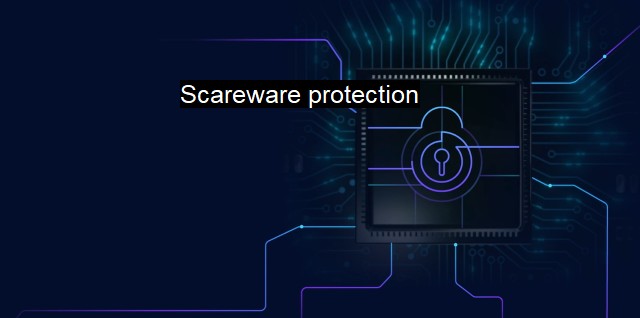What is Scareware protection?
Scareware Protection: Safeguarding Your System and Your Sanity Against Deceptive Cyber Scams and Rogue Security Software
Scareware protection is a critical element in the field of cybersecurity and antivirus. scareware protection protects computer systems from a deceptive type of software known as "scareware". As the name suggests, this software operates through a strategy of fear, attempting to trick users into believing that their computer is severely infected with malicious threats or not performing well. By exploiting users' fears about digital threats, scareware attempts to convince them to buy and install supposedly powerful antivirus software, which in reality is unneeded, ineffective, or even another tier of malware itself. Hence, the relevance of scareware protection starts rising, as it averts such detriments from impacting the system's functionality and performance.Scareware belongs to a broader malware family known as 'rogue security software'. This type of software pretends to be legitimate security software and uses alarming warning messages about fabricated or exaggerated security threats to trick unwary or uninformed users into purchasing a 'full version' or 'professional edition' for comprehensive protection. Alternatively, some scareware may force users to download its imitation software by locking their computer or redirecting all browsing activities until the user agrees to install the deceitful program.
One of modern cybersecurity's paramount tasks is scareware protection. Implementing it involves both strategic and specialized measures to achieve a high degree of protection. Starting with regular and thorough software and system maintenance, scareware protection also includes using trusted and competent antivirus programs, making sure to update them consistently since new types of threats emerge daily. Also, scareware protection incorporates educating users to avoid suspect or loose websites known to be vectors for scareware and other forms of malware.
Doing regular analysis and scans also forms a part of scareware protection, allowing the recognition of potential threats before they cause disturbances in the system. Reliable antivirus software should manage to track any suspicious activity automatically, alert the user about the detection, and handle the threat effectively or guide the user to do so.
Tools for scareware protection customize their operations according to the specific types of threats system might confront. Reliable and sturdy scareware protection will constantly check user behavior for any irregularities and identify any illicit manipulations that the user would not ordinarily run. Such measures hence encapsulate a vital part of the reactive capability of scareware protection tools, making sure that these rare but potent threats do not sneak around the preliminary defence.
Coordinates to that, updating systems and software should be innate to any cybersecurity tool, and scareware protection indeed isn't an exception. A system vulnerable to some levels might invite threats unbeknown, and keeping every element of the system updated aids in plugging such loopholes, removing critical vulnerabilities in the system.
Security experts and professionals have an essential role in designing and implementing scareware protection strategies. They liaise with developers, network managers, technicians, end-users, and a broad range of other stakeholders to create robust security frameworks. Broadly speaking, scareware protection involves a collective team effort because decision-making processes about what to implement and how contribute significantly to constructing a collective security barrier.
Scareware protection is all about maintaining the system's integrity and protecting it from possible threats that scareware falsely claims or poses itself. Remember that effective scareware protection does not only revolve around technical measures but also essential user practices. These include avoiding suspicious sites, ignoring unsolicited communications, being skeptical of too-good-to-be-true offers, generic scare alerts, and keeping antivirus software and operating systems current and robust. Thus, cybersecurity's pillar, scareware protection, functions by not spacing away from basic preventive measures while implementing profound, customized protective infrastructure.

Scareware protection FAQs
What is scareware protection?
Scareware protection refers to the measures taken to protect a computer or network from fake security alerts and other scare tactics used by cybercriminals to trick users into downloading and paying for unnecessary or fake antivirus software.How do I protect myself from scareware attacks?
You can protect yourself from scareware attacks by being cautious when downloading software or clicking on links, keeping your antivirus software up to date, and avoiding any pop-ups or alerts that seem suspicious or too good to be true.What are some common signs of a scareware attack?
Common signs of a scareware attack include frequent pop-up alerts warning of viruses or malware on your computer, offers to buy unnecessary antivirus software, and sudden changes in your device's performance or behavior.What should I do if I think I have encountered scareware?
If you think you have encountered scareware, it is important to avoid clicking on any pop-ups or alerts and immediately run a scan with your antivirus software. You should also consider disconnecting your device from the internet and seeking assistance from a cybersecurity professional if you are unsure how to proceed.| | A | | | B | | | C | | | D | | | E | | | F | | | G | | | H | | | I | | | J | | | K | | | L | | | M | |
| | N | | | O | | | P | | | Q | | | R | | | S | | | T | | | U | | | V | | | W | | | X | | | Y | | | Z | |
| | 1 | | | 2 | | | 3 | | | 4 | | | 7 | | | 8 | | |||||||